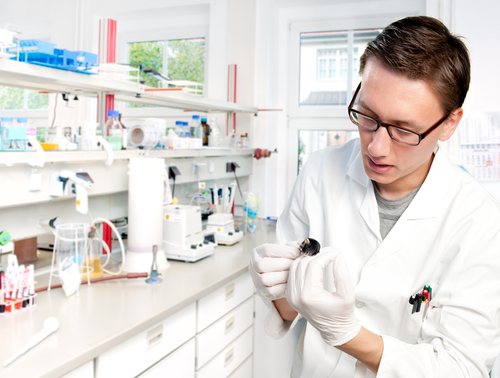CRISPR Gene Editing Therapy Is Promising in New Mixed Model

A CRISPR-Cas9-based gene editing therapy promoted the production of a smaller but functional version of the dystrophin protein in a new mixed mouse model that uses muscle cells derived from Duchenne muscular dystrophy (DMD) patients.
The therapy is designed to delete a DMD gene region that is commonly mutated in people with DMD.
This is one of the first studies to prove the efficacy of this type of gene editing therapy in adult cells within a living organism, as opposed to patient cells grown in a lab dish. According to researchers, this type of data is important to support the evaluation of this gene-editing strategy in patients.
This new mouse model may be useful to test different kinds of investigational therapies and provide additional information on the potential application of gene editing or gene therapy for DMD, the investigators added.
The study, “In vivo genome editing in mouse restores dystrophin expression in Duchenne muscular dystrophy patient muscle fibers,” was published in the journal Genome Medicine.
DMD is caused by the loss of dystrophin, a key protein for muscle strength, due to mutations in the DMD gene. The most common Duchenne-causing mutations involve the deletion of one or more of its 79 exons — sections of genetic information needed to make proteins.
This deletion breaks the ability of the remaining exons to link together properly in an intermediate process of protein production, impairing the generation of a functional or properly working dystrophin protein.
To treat this, several therapeutic strategies have been developed to skip or permanently delete one or more DMD exons. The goal is to restore proper alignment of the remaining exons and allow the production of a working — although usually smaller — protein.
Originally discovered in bacteria as a defense mechanism, the CRISPR-Cas9 system allows researchers to edit parts of the genome by adding, removing, or changing specific sections of the DNA sequence.
Previous studies have shown that CRISPR-Cas9-mediated corrections of the DMD gene are highly effective at increasing the levels of functional dystrophin in patient-derived cells grown in the lab, and in mouse and dog models of DMD.
However, “an important step for the clinical translation of this gene-editing strategy is to demonstrate its efficacy and safety in human muscle fibers in vivo [in living animals],” the researchers wrote.
To fill this knowledge gap, a team from China created a new DMD mouse model harboring patient-derived muscle cells, called PDX DMD, and evaluated the effects of three different CRISPR-Cas9-based gene editing therapies in this model.
The first strategy was designed to promote the deletion of DMD exons 45–55, which account for about 63% of DMD-causing mutations, while the second set of deleted exons, 46–54, was thought to result in a potentially better working dystrophin protein. The last strategy targeted a specific region of exon 50 to restore the alignment of the remaining exons.
CRISPR gene editing components were delivered to cells through a modified version of an adeno-associated virus, often used in gene therapy.
The results showed that the first and second strategies, involving large deletions of the DMD gene, were highly effective at restoring dystrophin production. The researchers injected the gene therapy directly into the mice’s leg muscles that contained patient-derived muscle fibers.
Notably, dystrophin was detected in more than 10% of patient-derived muscle fibers in mice treated with either one of such strategies, while the third strategy was “inefficient in restoring dystrophin,” the researchers wrote.
Suggesting that the restored dystrophin was functional, both dystrophin and beta-dystroglycan — a molecule that forms a complex with dystrophin to provide structure to muscle cells — were found at their correct location in all rescued human muscle fibers.
The team also found that a potentially more specific CRISPR system, called CRISPR-Cas12a, was as effective as CRISPR-Cas9 at increasing the levels of a functional, but shorter, version of the dystrophin protein when designed to delete exons 46–54.
As such, the CRISPR-Cas12a system may be an alternative method for future gene editing therapy in DMD, the researchers noted.
“This study provides evidence for the efficacy of in vivo genome editing to correct disruptive mutations and restore dystrophin expression and function in DMD patient-derived muscle fibers,” they wrote.
Also of note, the large deletion strategies appeared to be more effective at restoring dystrophin and “might meet the requirements of clinical efficacy,” they added.
In addition, “the PDX DMD mouse model can be used to screen potentially effective strategies for clinical application,” the team wrote.
“The continued studies of gene-editing strategies, gene delivery approach, toxicology, and immunology in large animals will provide further insights into the potential application of gene therapy for DMD,” the researchers concluded.






